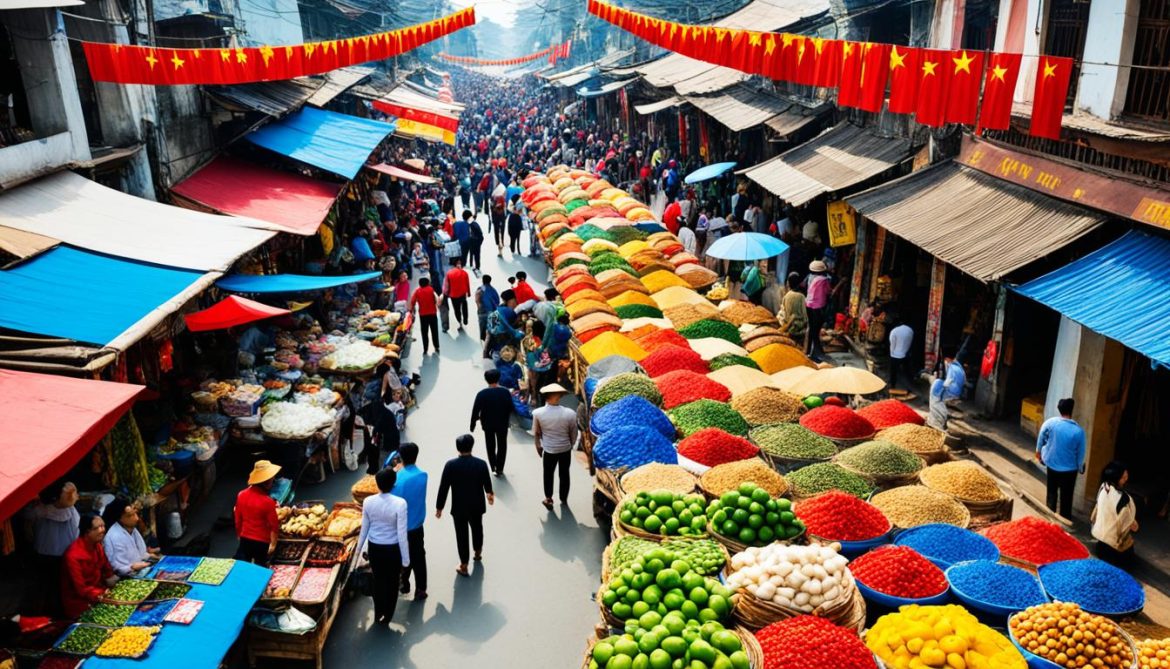Vietnam is a captivating country that attracts visitors from around the world. It is known for its beautiful coastline, rich culture, and delicious cuisine. In addition to these well-known aspects, Vietnam also has many unique and fascinating facts that make it a truly captivating destination. Let’s dive into the top facts about Vietnam that will surely spark your interest.
Key Takeaways:
- Vietnam is loved for its stunning coastline, vibrant culture, and mouthwatering cuisine.
- Explore Vietnam’s natural wonders, such as the Son Doong Cave and Ha Long Bay.
- Discover the rich history and cultural heritage of Vietnam, including its UNESCO World Heritage Sites.
- Understand the significance of the Vietnam War in shaping the country’s past.
- Indulge in the fresh and diverse flavors of Vietnamese cuisine, including iconic dishes like pho and banh mi.
Vietnam’s Natural Wonders
Vietnam is a country that is blessed with breathtaking natural wonders. From awe-inspiring caves to stunning bays, Vietnam’s geography offers a diverse range of landscapes that will leave you in awe.
Son Doong Cave – The World’s Largest Cave
Son Doong Cave, located in Phong Nha-Kẻ Bàng National Park, is an underground paradise that will take your breath away. As the largest cave in the world, it boasts a mesmerizing ecosystem that includes an underground river and giant stalactites. Exploring Son Doong Cave is like stepping into another world, where nature’s wonders unfold at every turn.
Ha Long Bay – A UNESCO World Heritage Site
Ha Long Bay is a true treasure of Vietnam. This UNESCO World Heritage Site is famous for its limestone karsts and picturesque islands that dot the emerald waters. Cruising through Ha Long Bay offers a mesmerizing experience as you witness the breathtaking beauty of nature’s creations.
Vietnam’s Diverse Geographical Landscapes
Vietnam’s geography is incredibly diverse, providing a wide range of stunning landscapes to explore. The enchanting Mekong Delta with its intricate network of waterways is a sight to behold. Here, you can immerse yourself in the unique charms of river life and witness the daily activities of local communities.
On the other hand, the mountainous region of Sapa offers a different kind of beauty. Its majestic peaks and terraced rice fields create a breathtaking panorama that will leave you awe-inspired. The unique blend of nature and local culture in Sapa makes it a must-visit destination for any traveler.
“Vietnam’s natural wonders are truly awe-inspiring. From the awe-inspiring Son Doong Cave to the breathtaking Ha Long Bay, nature’s creations in Vietnam will leave you speechless.”
Whether you’re an adventure seeker or a nature lover, Vietnam’s natural wonders will captivate your heart and soul. The country’s diverse landscapes offer a glimpse into the beauty and magnificence of the natural world. It’s no wonder that Vietnam is a popular destination for travelers looking to connect with nature and experience the wonders it has to offer.
| Vietnam’s Natural Wonders | Description |
|---|---|
| Son Doong Cave | The world’s largest cave located in Phong Nha-Kẻ Bàng National Park. Features an underground river and giant stalactites. |
| Ha Long Bay | A UNESCO World Heritage Site known for its limestone karsts and beautiful islands. |
| Mekong Delta | A picturesque delta with intricate waterways. |
| Sapa | A mountainous region with majestic peaks and terraced rice fields. |
Vietnamese History and Culture
Vietnam has a fascinating history deeply intertwined with its vibrant culture. Over the centuries, the country has been influenced by various civilizations, most notably China. In fact, the Vietnamese language originated from Chinese characters before developing its unique script.
One of the remarkable aspects of Vietnamese history is the preservation of its cultural heritage. Vietnam is home to several UNESCO World Heritage Sites that showcase its historical and architectural significance. Two notable examples are the Ancient Town of Hoi An, known for its well-preserved trading port dating back to the 15th century, and the Hue Historical Complex, which houses imperial palaces, tombs, and temples from the Nguyen Dynasty.
The Vietnamese people take immense pride in their rich cultural traditions, which are evident in various aspects of their daily lives. One iconic symbol of Vietnamese culture is the traditional clothing called ao dai. The ao dai is a long, elegant tunic worn by both men and women, featuring vibrant colors and intricate patterns that represent Vietnamese aesthetics.
Another notable aspect of Vietnamese culture is its cuisine. Vietnamese food is renowned worldwide for its fresh flavors and diverse dishes. The country’s culinary traditions reflect a fusion of flavors from different regions, resulting in a unique culinary experience. Vietnamese cuisine includes iconic dishes such as pho, a comforting noodle soup, and banh mi, a delicious sandwich filled with a variety of ingredients.
To truly appreciate the beauty of Vietnamese history and culture, immerse yourself in the country’s traditions and explore its UNESCO World Heritage Sites. Experience the vibrant colors of the ao dai and savor the flavors of Vietnamese cuisine.
Notable UNESCO World Heritage Sites in Vietnam
| Site | Category | Year Inscribed |
|---|---|---|
| Ancient Town of Hoi An | Cultural | 1999 |
| Hue Historical Complex | Cultural | 1993 |
| My Son Sanctuary | Cultural | 1999 |
| Ha Long Bay | Natural | 1994 |
The Vietnam War
The Vietnam War, also known as the Second Indochina War, was a significant event in Vietnam’s history. Lasting from 1955 to 1975, it had a profound impact on both Vietnam and the world. The war originated from the conflict between North Vietnam, supported by the Soviet Union and China, and South Vietnam, supported by the United States and its allies.
The Vietnam War resulted in the reunification of Vietnam under communist rule and led to the withdrawal of U.S. troops. It remains a sensitive topic, but it is an important part of understanding Vietnam’s past.
If you want to learn more about the Vietnam War, here are some key facts:
- The war began after the North Vietnamese launched an attack on the South in 1955.
- The United States became heavily involved in the conflict to prevent the spread of communism.
- It was the first televised war, bringing the brutality and devastation of the conflict into people’s living rooms.
- The war saw the extensive use of guerilla warfare tactics by the Viet Cong.
- Agent Orange, a herbicide used by the U.S. military, caused significant environmental and health issues.
Despite the war’s tragic and controversial nature, it remains an important chapter in Vietnam’s history and continues to shape the country today.

Perspective from a Vietnamese Veteran:
“The Vietnam War was a difficult and painful period for our country. Many lives were lost, families torn apart, and the scars still remain. It is important to remember the lessons of the past and strive for peace and reconciliation.”
Vietnamese Cuisine
Vietnamese cuisine is renowned for its fresh flavors and diverse dishes. The cuisine reflects the country’s historical and cultural influences, making it a true culinary delight. Let’s explore some fascinating Vietnamese cuisine facts.
“Vietnamese cuisine is a harmonious combination of flavors, textures, and colors, resulting in dishes that are both visually stunning and incredibly delicious.”
The Iconic Dishes
Two of the most iconic Vietnamese dishes that have gained international popularity are pho and banh mi. Pho is a comforting noodle soup that is usually made with beef or chicken. The flavorful broth, tender meat, and fresh herbs make it a beloved dish among locals and visitors alike.
Banh mi, on the other hand, is a delicious sandwich filled with a variety of ingredients. It typically features grilled pork, pickled vegetables, fresh herbs, and a tangy sauce. The combination of flavors and textures in banh mi is truly exceptional.
The Coffee Culture
When it comes to beverages, Vietnam is known for its coffee. Traditional Vietnamese coffee is a unique and flavorful experience. It is typically made through a slow drip process, resulting in a rich and aromatic cup of coffee. Condensed milk is often added for a touch of sweetness.
A Table of Vietnamese Delicacies
| Dish | Description |
|---|---|
| Pho | A comforting noodle soup usually made with beef or chicken |
| Banh Mi | A delicious sandwich filled with various ingredients like grilled pork, pickled vegetables, and fresh herbs |
| Cha Ca | Turmeric-marinated fish served with dill, noodles, and peanuts |
| Goi Cuon | Fresh spring rolls made with rice paper, filled with shrimp, pork, herbs, and vermicelli |
| Bun Cha | Grilled pork served with rice vermicelli, fresh herbs, and a savory broth |
The Verdict
Vietnamese cuisine is a feast for the senses. From the fragrant bowls of pho to the mouthwatering bites of banh mi, every dish tells a story and is crafted with care. Exploring the diverse flavors of Vietnamese cuisine is a must for any food lover.
Vietnamese Traditions and Performances
Vietnam is a country steeped in rich cultural traditions that have been passed down through generations. These traditions and performances are an integral part of Vietnamese society, showcasing the country’s unique heritage and captivating visitors from around the world.
One of the most mesmerizing traditional art forms in Vietnam is water puppetry. Originating in the Red River Delta, water puppet shows feature intricately crafted puppets that “perform” on water. The puppeteers skillfully manipulate the puppets using long poles hidden beneath the water’s surface. The combination of vibrant music, storytelling, and the enchanting puppetry creates a truly mesmerizing experience for audiences.
Another highlight of Vietnamese cultural traditions is the vibrant festivals celebrated throughout the year. One notable festival is Tet Nguyen Dan, commonly known as the Lunar New Year. This festival marks the beginning of the lunar calendar and is a time of family reunion and celebration. Elaborate ceremonies, colorful decorations, and traditional dances are part of the festivities, creating a lively and joyous atmosphere.
The Mid-Autumn Festival is another significant event in Vietnam, especially for children. It is celebrated on the 15th day of the 8th lunar month and is associated with the legend of the Moon Lady. During this festival, children carry lanterns and participate in processions while enjoying delicious mooncakes. The festival is also known for its lion and dragon dances, which add an element of excitement and entertainment to the celebrations.
Vietnamese cultural traditions and performances provide a captivating glimpse into the country’s rich heritage. From the enchanting water puppetry shows to the vibrant festivals, these traditions reflect the values, beliefs, and artistic expressions of the Vietnamese people.
| Traditional Art Form | Description |
|---|---|
| Water Puppetry | A captivating form of puppetry where intricately crafted puppets “perform” on water, accompanied by lively music and storytelling. |
| Tet Nguyen Dan | The Lunar New Year festival celebrated with elaborate ceremonies, colorful decorations, and traditional dances, symbolizing family reunion and good fortune. |
| Mid-Autumn Festival | A festival celebrated with lanterns, mooncakes, and vibrant lion and dragon dances, honoring the legend of the Moon Lady and bringing joy to children. |
Conclusion
Vietnam is a captivating and diverse destination that offers a plethora of travel experiences. From its stunning natural wonders to its rich history and vibrant culture, there are countless reasons why Vietnam should be at the top of your travel list. Whether you’re a nature enthusiast looking to explore jaw-dropping landscapes or a history buff eager to delve into the country’s fascinating past, Vietnam has something for everyone.
One of the standout features of Vietnam is its breathtaking natural wonders. From the awe-inspiring Son Doong Cave, the world’s largest cave, to the picturesque Ha Long Bay with its majestic limestone karsts, the country’s geography is a sight to behold. Immerse yourself in the tranquility of the Mekong Delta or embark on a hiking adventure in Sapa’s lush mountains – Vietnam’s natural beauty will leave you mesmerized.
But Vietnam isn’t just about its impressive landscapes; it’s also a country steeped in history and culture. The Vietnamese people take pride in their rich heritage, evident in their UNESCO World Heritage Sites like the Ancient Town of Hoi An and the Hue Historical Complex. Experience the allure of Vietnamese traditions through captivating performances, such as the enchanting water puppet shows, and immerse yourself in lively festivals like Tet Nguyen Dan and the Mid-Autumn Festival.
No journey to Vietnam would be complete without indulging in its world-renowned cuisine. From savoring a steamy bowl of pho, the iconic noodle soup, to relishing the flavors of banh mi, a delectable Vietnamese sandwich, the country’s culinary offerings are sure to tantalize your taste buds. And don’t forget to try the unique and flavorful Vietnamese coffee, an experience that will awaken your senses.
So, if you’re ready for an adventure like no other, plan your trip to Vietnam and get ready to be captivated by its natural wonders, immerse yourself in its rich history and culture, and indulge in its mouthwatering cuisine. Vietnam is waiting to leave you with unforgettable memories that will last a lifetime.
FAQ
What are some interesting facts about Vietnam’s natural wonders?
Vietnam is home to the largest cave in the world, Son Doong Cave, and the UNESCO World Heritage Site Ha Long Bay, known for its limestone karsts and beautiful islands.
How has Vietnam’s history and culture been influenced?
Throughout the centuries, Vietnam has been influenced by various civilizations, including China. The Vietnamese language was originally written in Chinese characters before developing its own script. Vietnam is also known for its UNESCO World Heritage Sites, such as the Ancient Town of Hoi An and the Hue Historical Complex.
What was the Vietnam War and its impact on Vietnam?
The Vietnam War, also known as the Second Indochina War, was a significant event in Vietnam’s history. It lasted from 1955 to 1975 and led to the reunification of Vietnam under communist rule. The war remains a sensitive topic, but it is an important part of understanding Vietnam’s past.
What are some iconic dishes in Vietnamese cuisine?
Two popular Vietnamese dishes are pho, a comforting noodle soup, and banh mi, a delicious sandwich filled with a variety of ingredients. Vietnamese coffee is also well-known for its unique and flavorful experience.
What are some traditional Vietnamese cultural performances?
Water puppetry is a traditional art form that originated in Vietnam’s Red River Delta. Water puppet shows feature intricately crafted puppets that “perform” on water. Vietnam is also known for its vibrant festivals, such as Tet Nguyen Dan (Lunar New Year) and the Mid-Autumn Festival, which are celebrated with elaborate ceremonies, colorful decorations, and traditional dances.
Why should I visit Vietnam?
Vietnam is a captivating and diverse country with stunning natural landscapes, a rich history and culture, delicious cuisine, and vibrant traditions. Whether you’re interested in exploring beautiful caves, immersing yourself in cultural heritage, or indulging in mouthwatering street food, Vietnam has something for everyone.







